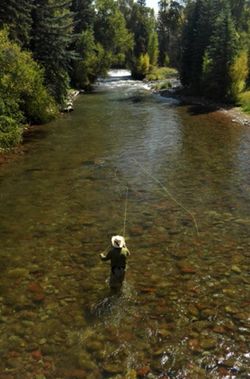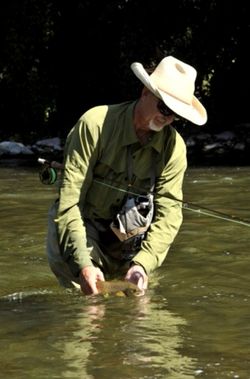
Appreciate your environment–Fly-fishing is about experiencing nature at its finest. Standing in a stream or beside a clear alpine lake, gracefully casting a fly to a beautiful, brightly colored rising trout is the quintessential mountain experience. When I take beginners or experienced fly-fishers on an outing, I try to always remind them to stop and look around and appreciate their surroundings. Most fly-fishing settings are in some of the most beautiful settings you can imagine. Enjoy the experience and you will sometimes find yourself feeling that catching fish is secondary to being part of the natural world around you.
Learn to cast reasonably well–In order to really enjoy your fishing, you should take the time to learn to cast adequately. Rarely when fishing fresh water do I find it necessary to cast more than 30 feet. Distance is not important, so practice your basic cast until you are comfortable and fairly accurate. Get in the habit of watching your back cast until you feel your rod load and see the line straighten behind you. I find most students instinctively pick up on the timing if they watch their back cast. Also learn the basic roll cast; it will save you many flies. As for beginners’ equipment, a great set up would be 's 9-foot 5-weight Demon Rod ($349) and Swift MK II 900 reel ($275). This set up is a great value and the reel has a modern, multi-disk drag system.

Learn to read the water and think like a fish–Most wild things seek to conserve energy and find their food using the least amount of energy. On faster water, you will find fish in eddies and behind rocks as well as on the slower side of a current seam. I cannot tell you how many fish I’ve caught by plopping a grasshopper pattern in the middle of a foam-covered eddy. When you lean how to read the waters and fish new water, you find you can simply walk the stream, read currents, and know where the fish will be.
Stay open-minded and ask questions–I find most fly-fishers are eager to share their knowledge and help beginners. I don’t believe there is such a thing as a master fly-fisher; you should always be observing and learning every time you are on the water. Exercise good etiquette on the water. Approach other fishermen with caution and respect. If you decide to pass them on the stream, give them a wide berth. Respect the waters others are fishing and will be fishing. Sometimes, when fishing new water, I have approached a pool and found it occupied by another fisherman. I quietly sit down and observe that person fishing and his techniques. Eventually, he notices me and usually initiates a conversation. More often than not, I leave with a wealth of new knowledge, a new fishing friend, and, sometimes, some new fly patterns without ever wetting a line.
For more on , see ���ϳԹ���'s .
–Aileen Torres